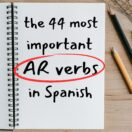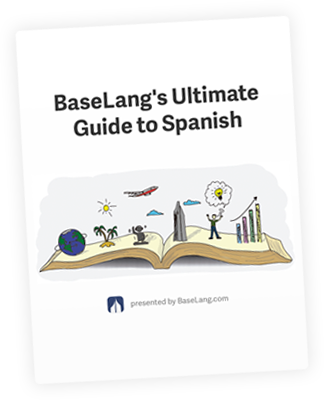Hay in Spanish: The Complete Guide to “There are”

Get our free email course, Shortcut to Conversational.
Have conversations faster, understand people when they speak fast, and other tested tips to learn faster.
More infoIn this guide, we explain the important word hay in Spanish.
We use hay (there is / there are) to say that something exists.
When we want to indicate that the quantity of something is zero we use no hay (there is not / there are not).
Unlike in English, we use hay for both singular and plural sentences in present (no change between there is / there are).
In Spanish hay is used very frequently, and luckily, it’s one of the most refreshingly easy core words to learn!
Hay in Spanish: Singular countable nouns
We use hay in singular along with a handful of accompanying words depending on whether the objects we’re referring to are countable nouns or uncountable nouns. By countable nouns we’re talking about things where there’s an identifiable number of them, whereas with uncountable nouns we’re talking about things where there’s a quantity. We’ll explain each hay phrase here.
Hay un / Hay una – There is a / There is one
This is the straightforward use of hay in Spanish, where we just refer to the existence of something. The definite article un or una is necessary for a single countable noun.
- Hay un carro rojo afuera de mi casa. – There is a red car outside my house.
- Hay un restaurante nuevo. – There is a new restaurant.
No hay ningún / No hay ninguna – There is not / There’s no
This is to express the opposite of the previous one. Rather than using the indefinite article to say “no hay un,” we use ningún or ninguna, which are the masculine and feminine forms of the indefinite adjective meaning any, no, not one, none of, or not a single. Note that this exact same form is used when we talk about plural countable nouns!
- No hay ningún carro rojo afuera de mi casa. – There is no red car outside my house.
- No hay ningún perro en la calle. – There is not single a dog in the street.
¿Hay algún …? / ¿Hay alguna …? – Is there a …?
- ¿Hay algún carro rojo afuera de mi casa? – Is there a red car outside my house?
- ¿Hay algún estudiante nuevo? – Is there a new student?
Hay in Spanish: Uncountable Nouns
When we refer to uncountable nouns in English, we tend to use the indefinite article “some,” rather than trying to refer to them in singular or plural. We take a similar approach in Spanish, using the following hay phrases to talk about uncountable nouns. Remember that by uncountable, we’re referring to things where we might know the quantity or amount, but not the number.
These translations are all pretty straightforward, so we won’t include additional explanations aside from a couple of examples of context sentences for each.
Hay un poco de – There’s a little [bit of]
- Hay un poco de agua en el vaso. – There is a little water in the glass.
- Hay un poco de helado en la nevera. – There is a little bit of ice cream in the freezer.
Hay algo de – There’s some
- Hay algo de agua en el vaso. – There is some water in the glass.
- Hay algo de dinero en mi bolso. – There is some money in my purse.
Hay mucho / Hay mucha – There is a lot of
- Hay mucha agua en el vaso. – There is a lot of water in the glass.
- Hay mucho tiempo. – There’s plenty of time.
¿Hay algo de …? – Is there any …?
- ¿Hay algo de agua en el vaso? – Is there any water in the glass?
- ¿Hay algo de comida en la nevera? – Is there any food in the freezer?
No hay nada de – There isn’t any / There’s nothing
- No hay nada de agua en el vaso. – There isn’t any water in the glass.
- No hay nada que decir. – There is nothing to say.
Hay in Spanish: Plural
Since uncountable nouns don’t come in plural, we don’t need to worry about this detail here. We’ll introduce the hay phrases we use to talk about nouns in plural, a couple of which are identical to the ones we saw in singular!
Hay – There are
This phrase is the equivalent of the very first “hay un” phrase we saw for singular nouns. When we use this hay on its own, with no definite article and followed by any noun in plural, we’re simply stating the existence of those things. We can also use this form without articles, and insert a number instead to be specific.
- Hay niños en la calle. – There are children in the street.
- Hay doce naranjas en la canasta. – There are twelve oranges in the basket.
Hay muchos / Hay muchas – There are many / There are a lot of
If we just want to say there are a bunch of things, we use hay muchos or hay muchas. The actual number remains vague.
- Hay muchas naranjas en la canasta. – There are many oranges in the basket.
- Hay muchos dulces en mi bolsillo. – There are a lot of candies in my pocket.
Hay algunos / Hay algunas – There are some
Hay algunos is how we can be vague about the number of countable things we’re talking about, when we just want to say that there are some of them. We state the noun in plural with this hay phrase. Hay algunos is the equivalent of the hay algo de for uncountable nouns, which is always used in singular.
- Hay algunas personas en la calle. – There are some people on the street.
- Hay algunos niños en el centro comercial. – There are some kids in the mall.
No hay ningún / No hay ninguna – There are not any / There are no
Using the different forms of the indefinite adjective ningún can get confusing for English speakers, because in Spanish they’re used in the singular even when we’re talking about things in plural. We saw these exact same forms in our earlier section on single countable nouns; the same phrases are used to talk about plurals.
- No hay ninguna persona en la calle. – There are no people on the street.
- No hay ninguna tienda abierta aún. – There aren’t any stores open yet.
¿Hay algún …? / ¿Hay alguna …? – Are there …?
When we ask a question using hay algún, the same rules apply as we mentioned above with “no hay ningún.” With countable nouns, we use this this phrase and say them in singular; the plural is implied. We can therefore translate hay algún as is there or are there any.
- ¿Hay alguna persona en la calle? – Are there any people on the street?
- ¿Hay algún cajero automático cerca de aquí? – Is there a bank machine near here?
Hay in Spanish Conjugation
Hay conjugation is pretty simple (well, extremely simple compared to most Spanish verbs), since there’s only one verb form to learn in each tense.
Hay is the third-person impersonal form of the verb haber in the indicative simple present, meaning both there is and there are in Spanish. In other tenses, the conjugation differs between singular and plural.
In order to use hay in Spanish when speaking about the past and future, we recommend simply memorizing this first table with the basic conjugations in the indicative mood.
In the past había means there was and habían means there were, while in the future both habrá and habrán mean there will be.
| Simple present | Simple past | Simple future | |
|---|---|---|---|
| Singular | Hay | Había | Habrá |
| Plural | Hay | Habían | Habrán |
The participle of haber is habido, so this form will feature in all compound tenses. Don’t worry if you haven’t seen the perfect tenses yet. This blog post just wouldn’t be complete if we didn’t include them.
| Perfect | Past perfect | |
|---|---|---|
| Singular | Ha habido | Había habido |
| Plural | Han habido | Habían habido |
Other Uses of Hay
The focus of this blog post is on how to use Spanish hay meaning there is and there are. Nonetheless, we should mention that hay has other uses in Spanish that we cover in other blog posts.
When we use it with que, hay que expresses obligation in the same way as to have to in English. We explain this use along with other ways of expressing obligation in our post on hay que vs tener que.
Hay sounds similar to several other common little Spanish words, so we clear up each one in our post on hay, ahí, ay and allí.
And since we’ve seen these words in some of the hay expressions we’ve covered in this post, you may be interested in a full explanation of ningún vs ninguno.
Conclusion
Hay in Spanish is one of these fundamental words that Spanish speakers use all the time to express that there is something or there are some things. We can use hay on its own in some contexts, but mostly we use it as an integral part of a number of hay phrases that each have their specific uses.
In this post we covered these various hay phrases, explaining how each can be used to talk about the existence of things whether they’re singular or plural, and whether they’re countable nouns or uncountable nouns. We introduced each of these terms with usage examples to help you understand each one in context.
We wrapped up our post with the hay conjugation in each indicative form, with our focus on the three simple tenses used most. Finally, we provided a few links to our other Spanish lessons where you can expand your knowledge on related topics like using hay que to express obligation. Thanks for reading!
Hay Practice Quiz
The best way to learn how to use hay in Spanish is with some practice where you need to generate (not just recognize) the correct answer.
For extra practice outside of these exercises, we even offer you our private flashcards that our students use to memorize the forms of hay and plenty of other lessons in Spanish.
Exercise 1: Hay with quantities
Fill in the blanks as appropriate with images using one of the hay phrases we learned above. Choose between the following: hay – hay un – hay una – hay algunos – no hay ningún – no hay ninguna – hay un poco de – hay algo de – no hay nada de.
1. _____ patos amarillos.
2. _____ manzanas rojas.
3. _____ bebé.
5. _____ cerveza en el vaso.
7. _____ pizza en la caja.
9. _____ vino en la copa.
10. _____ persona en las escaleras.
Answers:
- Hay algunos patos amarillos.
- Hay algunas manzanas rojas.
- Hay un bebé.
- Hay algunos carros en la calle.
- Hay un poco de / Hay algo de cerveza en el vaso.
- No hay nada de comida en el plato.
- Hay un poco de / Hay algo de pizza en la caja.
- Hay un poco de / Hay algo de comida en el plato.
- No hay nada de vino en la copa.
- Hay una persona en las escaleras.
Exercise 2: Hay with quantities
Multiple choice: Pick the correct answer to fill in the blanks.
1. _____ de agua en la bañera.
(Mucha – No hay nada – Hay una – Hay algunos)
2. ¿ _____ platos en lava platos?
(Hay – Hay un poco de – No hay nada de – Hay una)
3. _____ de vino en la copa.
(Hay un poco – No hay ningún – ¿Hay algún – Hay muchos)
4. _____ fichas en la mesa.
(Hay algunos – Hay algunas – Hay un – Hay un poco)
5. _____ corbatas en la mesa.
(Hay algo de – No hay nada de – Hay una – Hay muchas)
Answers:
1. No hay nada de agua en la bañera.
2. ¿Hay platos en lava platos?
3. Hay un poco de vino en la copa.
4. Hay algunas fichas en la mesa
5. Hay muchas corbatas en la mesa.
That’s all for this lesson!


















